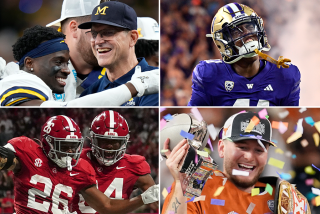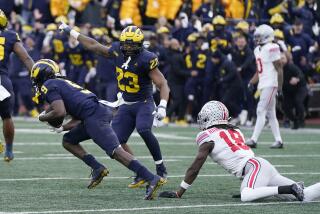POLLER OPPOSITES
- Share via
BUFFALO, N.Y. — As Miami eyes a possible third consecutive national title game appearance, the Buffalo Bulls brace for their fifth season in Division I-A.
Who knew there were the Buffalo Bulls?
The joke is that if you slur your words a bit, a prospect might think that it’s the Buffalo Bills calling.
There is a growing rift in college football between the haves and the have-nots, a substantial separation of power, and Miami and Buffalo represent the respective camps.
Miami has history, star power and five national championships.
Buffalo has, what, Niagara Falls?
Miami is our No. 1 and Buffalo is our No. 117.
Technically, both play major college football, and both must meet Division I-A criteria.
In reality, the only place Buffalo gets over on Miami is on the map.
Last season, Miami was one play from going undefeated; Buffalo went 1-11.
Miami will join the Atlantic Coast Conference next year and make the league a super conference.
Buffalo holds bottom rung in the Mid-American Conference’s East Division.
Third-year Bulls’ Coach Jim Hofher doesn’t even pretend to say he’s playing the same game.
“I think anybody in our league that has as their goal to be the national champions, that’s really foolish,” Hofher said this week while walking off the field after a morning practice.
Hofher said, until the rules are changed, there is no way his team can contend with the traditional powers.
In 1998, for instance, non-bowl championship series member Tulane ended up undefeated and only 10th in the polls.
“Right now, the way the cartel works, there’s only six conferences plus Notre Dame that get a chance to compete for the national championship,” he said.
“That’s the way it is, whether we like it or not.”
Buffalo, of course, did not have to take up major college football. In fact, the school dropped football in 1971 for financial reasons. The program returned in 1977 at the Division III level and later upgraded to Division I-AA before joining the MAC in 1999 as a Division I-A member.
Simply put, many equate big-time schools with big-time football.
A public university with enrollment of almost 30,000, Buffalo has always fancied itself as the state university in New York. It has, of late, looked to raise its profile.
Academically, Buffalo is one of only 62 schools of higher education that have gained membership to the Assn. of American Universities (AAU).
“Every Big Ten school is in the AAU, every Ivy League school,” Hofher said. “Half of the SEC, half of Big East, half of Big 12.
“UB believes that’s the company it keeps as an institution.... Why Division I? Because UB is a Division I university.”
Hofher says sports helps to sell the academic attributes of a school.
“The display to the department store is sports,” he said. “That’s what brings people in. If UB wanted to be a better department store, which it already is, then it needed to have a better display case.”
So far it has been window dressing on the field. Buffalo has gone 6-39 since upgrading to Division I-A. Last year, the Bulls averaged only 11,244 fans at UB Stadium.
Progress has been slow, although Buffalo scored its lone victory last year against Rutgers, a BCS-member school.
“Everyone involved is trying to put UB on the map,” Rahsad Clark, a senior defensive end from Los Angeles, said. “We struggled from the bottom, and now we’re working our way up.”
Clark said he hopes to be remembered as one of the first bricks in UB’s football foundation.
“I had the unique opportunity to come here and help build something,” he said. “So when I walk away, I can say I was part of that 2003 team that helped establish UB and helped put them on the map. And that’s the goal.”
Hofher says Buffalo isn’t looking for the easy way out.
He says it’s up to him to put a quality product on the field and fans in the seats.
Yet, he would like something to shoot for. He says a proposed fifth BCS game that would pit champions of the five non-BCS conferences would loosen the chokehold the six major conferences have over the revenue streams. The networks will pay BCS schools about $900 million over the eight-year contract, of which the non-BCS schools will receive $40 million.
Hofher understands the major networks pay the bills and that ABC will always want to show Michigan-Ohio State instead of Buffalo-Western Michigan.
All Buffalo wants, he said, is a piece of the inclusion pie.
“I’m not going to say the fight is on, that’s too dramatic,” he said. “But it is. Somehow, some way, simply for fairness and equity.”
*
(BEGIN TEXT OF INFOBOX)
#117 TIMES’ RANKING
BUFFALO BULLS
Conference: Mid-American
Last three seasons: 6-28
AP Ranking: Not ranked
* In a city of losers (Scott Norwood, the four-time Super Bowl-losing Bills, 93 inches of snow), the Bulls -- losers of 10 in a row -- blend right in.
More to Read
Go beyond the scoreboard
Get the latest on L.A.'s teams in the daily Sports Report newsletter.
You may occasionally receive promotional content from the Los Angeles Times.











